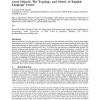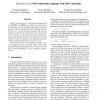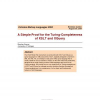788 search results - page 29 / 158 » Language Processing in Human Brain |
IJCNN
2008
IEEE
14 years 1 months ago
2008
IEEE
—A novel wake-sleep learning architecture for processing a robot’s facial expressions is introduced. According to neuroscience evidence, associative learning of emotional respo...
LREC
2010
13 years 9 months ago
2010
A considerable amount of work has been put into development of stemmers and morphological analysers. The majority of these approaches use hand-crafted suffix-replacement rules but...
GIS
1998
ACM
13 years 7 months ago
1998
ACM
Spatial relations are the basis for many selections users perform when they query geographic information systems (GISs). Although such query languages use natural-language-like te...
CAISE
2008
Springer
13 years 9 months ago
2008
Springer
Today's business process orchestration languages such as WS-BPEL and BPML have high-level constructs for specifying flow of control and data, but facilities for allocating ta...
EXTREME
2004
ACM
14 years 29 days ago
2004
ACM
The World Wide Web Consortium recommends both XSLT and XQuery as query languages for XML documents. XSLT, originally designed to transform XML into XSL-FO, is nowadays a fully gro...



